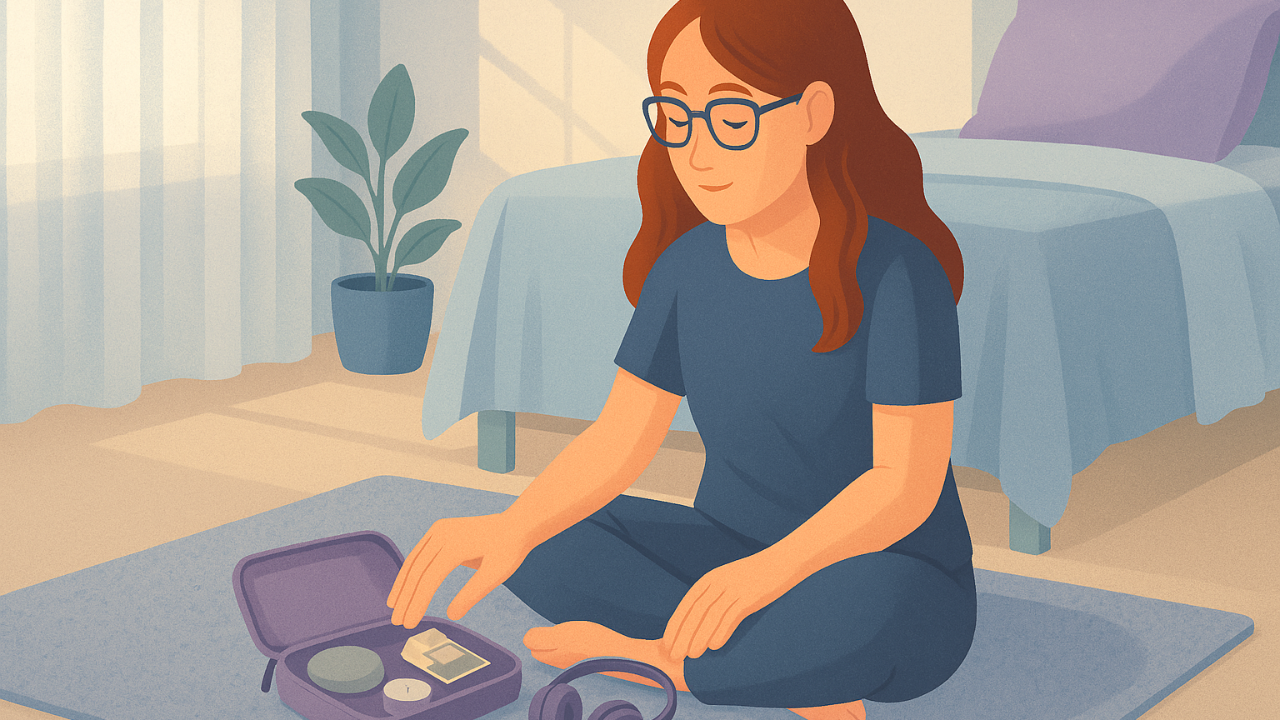
How to Build a Personal Safety Kit for Your Nervous System
When your body doesn’t feel safe
Sometimes your mind knows you’re fine, but your body doesn’t believe it.
Maybe your chest tightens before bed. Maybe noise or conflict makes you jump. Or maybe you go numb and disappear inside.
If that’s you, you’re not broken. Your nervous system just needs more cues of safety.
Before we go further, you can take the Stress Loop Quiz to understand how your body stays stuck in stress and what kind of tools might help you regulate: 👉 Take the Stress Loop Quiz
What is a personal safety kit?
A personal safety kit is a small collection of sensory tools, gentle reminders, and grounding practices you can use when your body feels unsafe.
It’s not about forcing calm. It’s about creating conditions where safety can return on its own.
You can think of it like a “first aid kit” for your nervous system, a set of cues that remind your body you are safe enough to soften.
What to include in your nervous system safety kit
You can build this kit with a small pouch, box, or basket. Choose what feels comforting to you.
1. Touch
- A smooth stone, soft cloth, or fidget ring to hold.
- A weighted item (like a small bean bag) to rest on your chest or lap.
- A cozy scarf to wrap around your shoulders.
Touch helps your brain anchor back into the present moment.
If you often freeze or dissociate, check out this simple somatic grounding guide for more ideas.
2. Smell
- Lavender, citrus, or grounding essential oil.
- A small sachet with coffee beans or herbs.
Scents directly signal your limbic system, the emotional brain, that it’s okay to relax.
3. Sight
- Photos or postcards that bring comfort.
- A short quote that helps you remember your strength.
- A soft light or candle.
Visual cues matter, especially if you tend to feel on alert.
You might also try a vagus nerve morning routine to begin the day with calm energy.
4. Sound
- A playlist of soft music or nature sounds.
- A recording of your own voice saying something kind.
- A humming or gentle chanting practice to engage the vagus nerve.
Humming can help quiet adrenaline and reconnect you with your breath. See how humming and gargling can calm your nervous system.
5. Taste
- Herbal tea bags or mints.
- A small piece of chocolate.
Taste grounds you through the present sensory experience.
You may also want to learn how the gut and brain are connected.
6. Movement
-
A printed list of simple movement cues: slow neck rolls, shoulder drops, soft shaking, gentle stretching.
These help your body discharge energy and return to regulation.
For ideas, try this safe tremoring exercise for stress releasegentle somatic shaking.
How to use your kit
Keep your kit somewhere visible—by your bed, in your bag, or at your desk.
Use it when you feel tension building, or when you feel numb and disconnected.
You don’t have to use everything at once. Just choose one sense, one cue of safety.
When your system learns it can return to calm again and again, that becomes your new normal.
A 7-Day Mini Plan to Feel Safe Again
Day 1: Choose your container and gather 3 items that feel grounding.
Day 2: Add one scent that soothes you.
Day 3: Make a short playlist of calm songs or nature sounds.
Day 4: Write a kind note to your future self.
Day 5: Add one item with texture that feels good in your hands.
Day 6: Practice using your kit when mildly stressed, not just during big moments.
Day 7: Reflect—what helped most? Adjust your kit to match what your body actually likes.
Common sticking points
“I forget to use it until it’s too late.”
That’s okay. Keep one small cue visible—a photo, stone, or word—to remind you. Over time, your brain will learn to reach for safety faster.
“Nothing feels calming.”
Sometimes you’re too activated to notice calm. Focus on less threat instead of instant peace. For example, “my shoulders dropped slightly” is a win.
“I feel silly doing this.”
Safety tools aren’t childish. They’re physiological. Your nervous system responds to repetition and sensory input, not logic.
If you’d like to understand which stress pattern your body stays in most, take the Stress Loop Quiz for personalized insights.
More Gentle Reads
Disclaimer: This article is educational and not medical advice. If you have health concerns, consider speaking with a qualified professional.
FAQs
1. What is the purpose of a nervous system safety kit?
It gives your body physical reminders that it’s safe, helping you move out of survival mode gently.
2. Can I make a digital version instead?
Yes. You can store calming playlists, photos, or notes on your phone in a “Safety Folder.”
3. What if I live with trauma and nothing feels safe?
Start with noticing one small neutral sensation—a sound, a color, a texture—and build from there. Gentle pacing matters.
4. How often should I use the kit?
As often as you need, especially before stress spikes. Over time, your body learns faster regulation.
5. Can this replace therapy or medication?
No. It’s a supportive tool, not a substitute for professional care.
Discover Your Vagal Tone
Find out how dysregulated your nervous system is and get your personalized roadmap to feeling calm, energized, and in control


